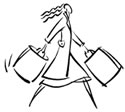 Supermarkets, pharmacies, home improvement, and department stores expose their customers to many potential accident sources such as floors and aisles, which can become unsafe, and display merchandize that can topple or cause tripping. To prevent such accidents from occurring, these establishments should maintain routine scheduled inspections to insure that unsafe conditions are detected and corrected before accidents occur. They must also anticipate that unsafe conditions can develop rapidly during rain and snow days and that product spills, display instabilities and product delivery equipment may be encountered by unsuspecting shoppers.
Supermarkets, pharmacies, home improvement, and department stores expose their customers to many potential accident sources such as floors and aisles, which can become unsafe, and display merchandize that can topple or cause tripping. To prevent such accidents from occurring, these establishments should maintain routine scheduled inspections to insure that unsafe conditions are detected and corrected before accidents occur. They must also anticipate that unsafe conditions can develop rapidly during rain and snow days and that product spills, display instabilities and product delivery equipment may be encountered by unsuspecting shoppers.
Expertise
We have extensive experience in many aspects of retail store accidents including:
- Slips, trips & falls
- Shopping carts
- Display and merchandise collapse
- Loading dock procedures
- Reference library with safety guidelines for food markets, delivery vehicles and merchandise displays
Questions Answered
Through scientific analysis, we can help you answer pertinent questions such as:
- Why did the shopping cart carrying the child topple over?
- How slippery was the floor?
- Why did the display collapse?
- Did the escalator meet all applicable safety standards?
- Were the proper warnings in place?
Case Examples
Shopping Cart Fall:
A 20 month old boy was seriously injured when the shopping cart he was riding in toppled to the side as his mother bent to pick up store items which had fallen. The case settled after we demonstrated how the accident was caused by the low side forces required to produce tipping, poor placement of warnings on the cart and the existence throughout the store of numerous defective wheel attachments.
Falling Lumber:
A carpenter was purchasing a 1" x 5" x 10' plank from a large home improvement store. The lumber was displayed in self-service bins. During the selection process, a 12' plank slid off from an adjacent bin and struck the carpenter, injuring him. After demonstrating that the lumber display was perfectly safe and could only have been in an unsafe position as a result of the carpenter's actions, a prior customer, the case was settled.
Kristopher J. Seluga, PE, is a Mechanical Engineering, Accident Reconstruction, Biomechanics, and Safety Expert with over 20 years of experience. He received his Bachelor's and Master's degrees from the Mechanical Engineering department at MIT where he worked on the development of novel three-dimensional printing technologies. Mr. Seluga is also a licensed Professional Engineer in New York and Connecticut, and has served as a member of the ANSI engineering committee for the Z130.1 and Z135 standards for golf cars and PTV's. His research interests and peer reviewed publications span the topics of Motor Vehicle Dynamics, Product Safety, and Biomechanics.
©Copyright - All Rights Reserved
DO NOT REPRODUCE WITHOUT WRITTEN PERMISSION BY AUTHOR.



 Supermarkets, pharmacies, home improvement, and department stores expose their customers to many potential accident sources such as floors and aisles, which can become unsafe, and display merchandize that can topple or cause tripping. To prevent such accidents from occurring, these establishments should maintain routine scheduled inspections to insure that unsafe conditions are detected and corrected before accidents occur. They must also anticipate that unsafe conditions can develop rapidly during rain and snow days and that product spills, display instabilities and product delivery equipment may be encountered by unsuspecting shoppers.
Supermarkets, pharmacies, home improvement, and department stores expose their customers to many potential accident sources such as floors and aisles, which can become unsafe, and display merchandize that can topple or cause tripping. To prevent such accidents from occurring, these establishments should maintain routine scheduled inspections to insure that unsafe conditions are detected and corrected before accidents occur. They must also anticipate that unsafe conditions can develop rapidly during rain and snow days and that product spills, display instabilities and product delivery equipment may be encountered by unsuspecting shoppers.







